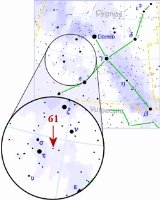
61 Cygni
Overview
16 Cygni
16 Cygni or 16 Cyg is a triple star system approximately 70 light-years away from Earth in the constellation of Cygnus. It consists of two Sun-like yellow dwarf stars, 16 Cygni A and 16 Cygni B, together with a red dwarf, 16 Cygni C...
, a more distant system containing two G-type
Stellar classification
In astronomy, stellar classification is a classification of stars based on their spectral characteristics. The spectral class of a star is a designated class of a star describing the ionization of its chromosphere, what atomic excitations are most prominent in the light, giving an objective measure...
stars harboring the gas giant
Gas giant
A gas giant is a large planet that is not primarily composed of rock or other solid matter. There are four gas giants in the Solar System: Jupiter, Saturn, Uranus, and Neptune...
planet 16 Cygni Bb
16 Cygni Bb
16 Cygni Bb or 16 Cyg Bb is an extrasolar planet approximately 70 light-years away in the constellation of Cygnus. The planet was discovered orbiting the sun-like star 16 Cygni B, one of two solar-mass components of the triple star system 16 Cygni...
. sometimes called Bessel's Star or Piazzi's Flying Star, is a binary star
Binary star
A binary star is a star system consisting of two stars orbiting around their common center of mass. The brighter star is called the primary and the other is its companion star, comes, or secondary...
system in the constellation
Constellation
In modern astronomy, a constellation is an internationally defined area of the celestial sphere. These areas are grouped around asterisms, patterns formed by prominent stars within apparent proximity to one another on Earth's night sky....
Cygnus
Cygnus (constellation)
Cygnus is a northern constellation lying on the plane of the Milky Way. Its name is the Latinized Hellenic word for swan. One of the most recognizable constellations of the northern summer and autumn, it features a prominent asterism known as the Northern Cross...
. It consists of a pair of K-type
Stellar classification
In astronomy, stellar classification is a classification of stars based on their spectral characteristics. The spectral class of a star is a designated class of a star describing the ionization of its chromosphere, what atomic excitations are most prominent in the light, giving an objective measure...
dwarf star
Dwarf star
The term dwarf star refers to a variety of distinct classes of stars.* Dwarf star alone generally refers to any main sequence star, a star of luminosity class V.** Red dwarfs are low-mass main sequence stars....
s that orbit each other in a period of about 659 years, forming a visual binary. At fifth and sixth apparent magnitude
Apparent magnitude
The apparent magnitude of a celestial body is a measure of its brightness as seen by an observer on Earth, adjusted to the value it would have in the absence of the atmosphere...
s, they are among the least conspicuous stars visible in the night sky to an observer without an optical instrument
Optical instrument
An optical instrument either processes light waves to enhance an image for viewing, or analyzes light waves to determine one of a number of characteristic properties.-Image enhancement:...
.
61 Cygni first attracted the attention of astronomers because of its large proper motion
Proper motion
The proper motion of a star is its angular change in position over time as seen from the center of mass of the solar system. It is measured in seconds of arc per year, arcsec/yr, where 3600 arcseconds equal one degree. This contrasts with radial velocity, which is the time rate of change in...
.

